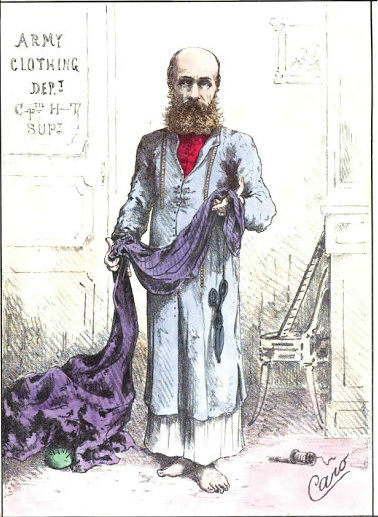Registered with the Registrar of Newspapers for India under R.N.I 53640/91
Vol. XXVII No. 4, June 1-15, 2017
Charivari – 1
A greater contribution in death

Lord Hobart
Charivari is a word that would today be considered archaic. Wikipedia informs us that it is of German origin and stood for a folk custom in which the community stages a mock serenade using pots and pans. Le Charivari, established in 1832, was a French satirical magazine and when the English felt the need for one in 1841, they called theirs Punch, or The London Charivari. The latter had a long and glorious career, folding up eventually in 2002.
Inspired by this and very much in the Punch tradition was the Indian Charivari, published at 7, D’Acres Lane, Calcutta in the 1870s. The magazine brought out an annual – The Indian Charivari Album. The series featured prominent people of the sub-continent and each word portrait by ‘Buck’, all packed with mild satire, was accompanied by a sketch attributed to ‘Caro’. Not much is known of who really produced this publication but it is rumoured that the brains were Wilkins Terry, later the head of the Sir J.J. School of Arts Bombay, and Lockwood Kipling, father of the better known Rudyard. The first volume is now available as a digital download and we were delighted to find in it some familiar names of Madras featured in it. Over the next few issues, we plan to publish, with our comments, the notes and pictures of these prominent men of Madras. We begin from the top, with a Governor, Vere Henry, Lord Hobart.
The profile has it that his Lordship was not considered entirely up to the mark for one of the “best appointments under the British Crown”, namely the Governorship of Madras. But then the Prime Minister, William Ewart Gladstone, had made up his mind and so many credentials were dug up to justify the offer. His ancestor, another Lord Hobart (and whose wife and son have memorials in St. Mary’s Church, Fort St. George) had once been Governor of Madras. He (the incumbent Governor and not his ancestor) was taking a keen interest in Eastern questions, was a Director of the Imperial Ottoman Bank in Constantinople, and, moreover, had a brother who was a “Pasha and Admiral in the Turkish Service”. Such justifications were enough and, so, Lord Hobart became Governor of Madras, in 1872.
Once here, as the Indian Charivari notes, he made very few mistakes, probably because he did little. The magazine gently chides him for spending more time in the “mountain retreats of Konnor and Utakamand” and notes that this had caused comment in the local Press. He was also a friend of the Muslims, often said to be favouring “co-religionists of his friends in Turkey”. The Government Hobart School for Muslim Girls in Royapettah commemorates him. The illustration rather aptly has him dressed in partly Turkish attire. Under him, the lower bureaucracy of Madras, dominated by Hindus till then, saw its composition changing.
It may have been best for Lord Hobart had he stayed on in Ooty. Coming back to Madras in 1875, he promptly contracted cholera and died. The funeral, the last in the city for a British Governor of Madras, was a solemn one, with the body being interred in St. Mary’s. There was an outpouring of grief that was rather surprising for a relatively lightweight Governor, but in retrospect entirely in keeping with the character of Madras. Hundreds lined the streets down which the cortege passed. A marble bust was put up at the southern corner of Government Estate, which after Independence was shifted to the Fort Museum. Lady Hobart donated a lectern in memory of her husband to the Church of St. Mary’s. This has since been replaced, but the brass plaque on the original was rather thoughtfully transferred to the new one. A Princess of Tanjore donated altar railings to the Church of St. Mary’s in memory of her good friend, Vere H. Hobart, and they still survive, complete with inscription.
The passing was not without benefit for the city, for the Governor’s physician, Dr. Robert Druitt, declared that the open drains of Triplicane were the chief culprits that caused the death. Hobart achieved with his passing what Florence Nightingale could not do with years of campaigning. Work began on covered drains in Madras city.

